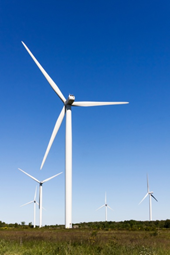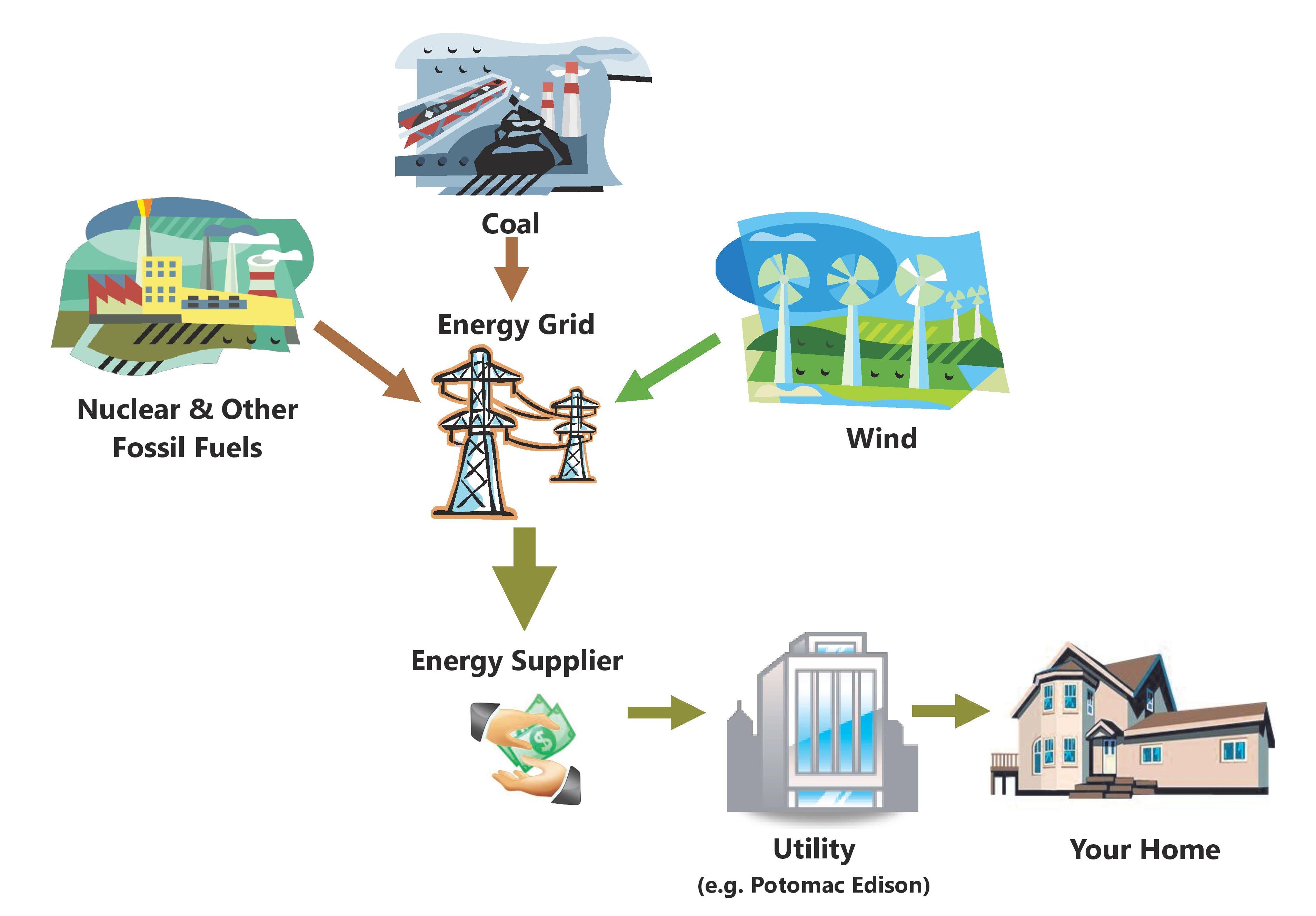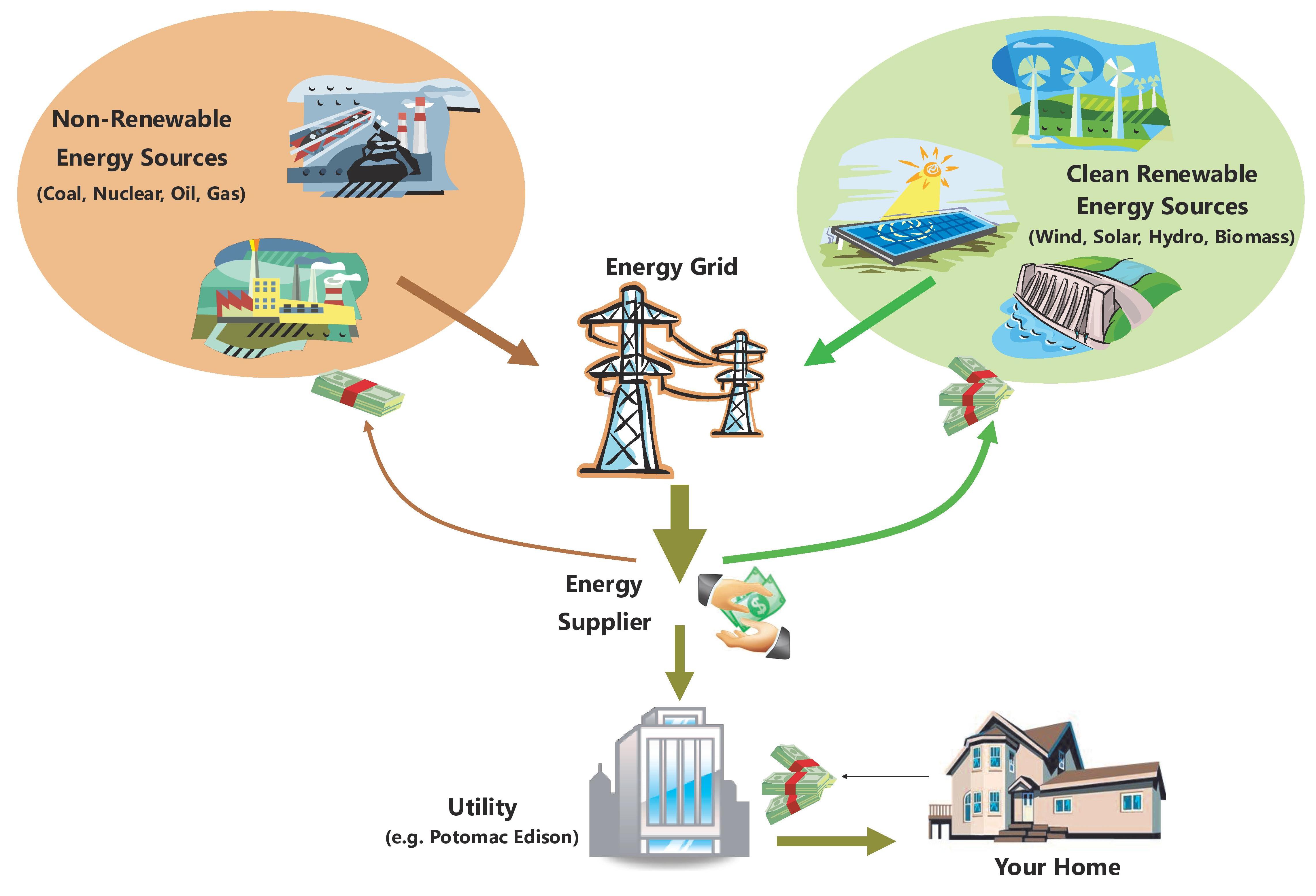What Is Clean Renewable Energy?
Clean energy is electricity generated from a renewable resource—such as wind, sunlight, thermal energy stored in the ground, methane from landfills, or sustainable biomass—that emits little or no pollution in the generation process. In contrast, fossil fuels like coal, oil, and gas aren't considered clean because of the pollution associated with their extraction from the earth and with the combustion process used to generate the power. The gases emitted when fossil fuels are burned include air pollutants and greenhouse gases.

Why Clean Energy?
Much of the electricity supplied to American homes today is generated by burning fossil fuels. For example, in 2011 61.66% of Potomac Edison’s electricity was generated from burning coal and gas and only 3.44% came from renewable sources (source). As a result, the average American home that uses standard electricity generates more greenhouse gases and pollution in a year than an average car generates during the same period! For example, based on the 2011 regional fuel mix for electricity generation, if your household used 1,000 kWh of standard electricity in one month, that would result in 1,293 pounds of carbon dioxide, 8 pounds of sulfur dioxide, and 3 pounds nitrogen dioxide being emitted into our atmosphere.
Switching to clean energy sources helps to:
- Reduce pollution and greenhouse gases by reducing the amount of coal, oil, and gas burned to create electricity;
- Boost the renewable energy market and increase regional demand for clean energy;
- Generate new jobs and revenue in clean energy generation, transmission, and installation;
- Encourage innovation in clean energy technology;
- Reduce your personal environmental footprint; and
- Promote national security by reducing dependence on foreign countries as sources of oil.
How Much Does Clean Energy Cost?
At present, clean energy supplied by local utilities costs you (the consumer) about the same as "standard" power (electricity generated by traditional sources such as oil and coal). However, this has not always been the case. In the past clean energy cost a little more than standard power. Why? Historically, renewable energy sources haven't received the same government subsidies and support as coal, oil, and gas to cover the costs of production and transport. Therefore, renewable energy generators have to set higher prices to cover their production expenses.
The Maryland Office of the People’s Council posts up-to-date electricity rates for suppliers serving the Potomac Edison Service area. Rates for clean energy, while very similar to Potomac Edison standard rates, vary slightly depending on how long your contract is and whether you opt for clean energy that is generated regionally or from other parts of the country. Note that the prices for clean energy and standard power will fluctuate over time, so it is a good idea to check the rates of suppliers periodically.
How Do I Buy Clean Energy?
The energy market in Maryland is deregulated, so you can choose your energy supplier and the type of energy you want to buy. If you haven't already entered into a contract with a competitive electricity supplier, you can switch suppliers today. If you already have a contract, be sure to check it before you switch products or suppliers! To avoid penalties, you might have to wait until your current contract expires to change suppliers.
Once you have chosen a supplier, you can buy clean energy online. All you need is your utility account number and your address, and you can sign up for clean energy through the supplier's website. The supplier will contact you by mail to confirm the change.
Learn more about energy deregulation and choosing an energy supplier through the Maryland Attorney General's Web site.
How Does Clean Energy Get to My Home?
You don't need to install special equipment to receive clean energy. By choosing a competitive energy supplier, you choose to buy a percentage or all of your electricity from clean energy sources like wind or solar. This clean energy is delivered to your house by your local utility, in the same way it provides regular energy.
The diagram below shows how energy moves from energy generators to your home. Electricity generated from nuclear, coal, wind, and other sources is transferred to the energy grid. Your local utility company (Potomac Edison) or your clean energy supplier purchases power from the electricity generators. This electricity is transmitted through the grid to your area and the utility company distributes it to your home.

Energy moves from energy generators to your home through the energy grid.
Though some of the energy available in the grid was generated using a renewable resource, this clean energy can't be distinguished from the millions of other electrons flying through the wires to reach your home or business. The electricity grid is like a big pool being filled with water from many hoses. The hoses are the different types of energy sources—coal, nuclear, wind, solar, etc. Once the water is in the pool, you can't tell which hose it came from; once the electricity is in the grid, you can't identify its source.
Energy suppliers can influence how much energy is transferred to the grid from each source by selectively purchasing energy from different generators. If, for example, an energy supplier purchases more energy from a generator that produces electricity from a renewable source, such as wind, more of the electricity available in the energy grid will come from a clean energy source (as shown in the figure below).

Energy suppliers influence the types of energy supplied to the grid.
By purchasing clean energy through a competitive energy supplier, you're creating a market for renewable energy and causing energy suppliers to purchase more energy from clean energy generators. You're directly affecting the amount of clean energy available in the grid and supporting energy generators that produce sustainable, renewable energy!
Contributor: Montgomery County Department of Environmental Protection